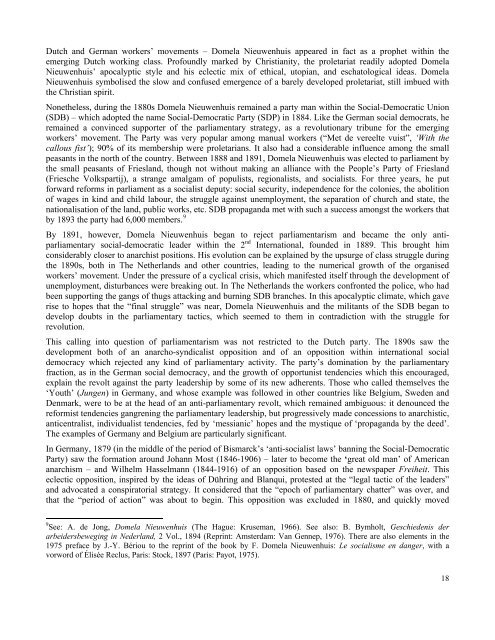The German-Dutch Communist Left - Libcom
The German-Dutch Communist Left - Libcom
The German-Dutch Communist Left - Libcom
Create successful ePaper yourself
Turn your PDF publications into a flip-book with our unique Google optimized e-Paper software.
<strong>Dutch</strong> and <strong>German</strong> workers’ movements – Domela Nieuwenhuis appeared in fact as a prophet within the<br />
emerging <strong>Dutch</strong> working class. Profoundly marked by Christianity, the proletariat readily adopted Domela<br />
Nieuwenhuis’ apocalyptic style and his eclectic mix of ethical, utopian, and eschatological ideas. Domela<br />
Nieuwenhuis symbolised the slow and confused emergence of a barely developed proletariat, still imbued with<br />
the Christian spirit.<br />
Nonetheless, during the 1880s Domela Nieuwenhuis remained a party man within the Social-Democratic Union<br />
(SDB) – which adopted the name Social-Democratic Party (SDP) in 1884. Like the <strong>German</strong> social democrats, he<br />
remained a convinced supporter of the parliamentary strategy, as a revolutionary tribune for the emerging<br />
workers’ movement. <strong>The</strong> Party was very popular among manual workers (“Met de vereelte vuist”, ‘With the<br />
callous fist’); 90% of its membership were proletarians. It also had a considerable influence among the small<br />
peasants in the north of the country. Between 1888 and 1891, Domela Nieuwenhuis was elected to parliament by<br />
the small peasants of Friesland, though not without making an alliance with the People’s Party of Friesland<br />
(Friesche Volkspartij), a strange amalgam of populists, regionalists, and socialists. For three years, he put<br />
forward reforms in parliament as a socialist deputy: social security, independence for the colonies, the abolition<br />
of wages in kind and child labour, the struggle against unemployment, the separation of church and state, the<br />
nationalisation of the land, public works, etc. SDB propaganda met with such a success amongst the workers that<br />
by 1893 the party had 6,000 members. 9<br />
By 1891, however, Domela Nieuwenhuis began to reject parliamentarism and became the only antiparliamentary<br />
social-democratic leader within the 2 nd International, founded in 1889. This brought him<br />
considerably closer to anarchist positions. His evolution can be explained by the upsurge of class struggle during<br />
the 1890s, both in <strong>The</strong> Netherlands and other countries, leading to the numerical growth of the organised<br />
workers’ movement. Under the pressure of a cyclical crisis, which manifested itself through the development of<br />
unemployment, disturbances were breaking out. In <strong>The</strong> Netherlands the workers confronted the police, who had<br />
been supporting the gangs of thugs attacking and burning SDB branches. In this apocalyptic climate, which gave<br />
rise to hopes that the “final struggle” was near, Domela Nieuwenhuis and the militants of the SDB began to<br />
develop doubts in the parliamentary tactics, which seemed to them in contradiction with the struggle for<br />
revolution.<br />
This calling into question of parliamentarism was not restricted to the <strong>Dutch</strong> party. <strong>The</strong> 1890s saw the<br />
development both of an anarcho-syndicalist opposition and of an opposition within international social<br />
democracy which rejected any kind of parliamentary activity. <strong>The</strong> party’s domination by the parliamentary<br />
fraction, as in the <strong>German</strong> social democracy, and the growth of opportunist tendencies which this encouraged,<br />
explain the revolt against the party leadership by some of its new adherents. Those who called themselves the<br />
‘Youth’ (Jungen) in <strong>German</strong>y, and whose example was followed in other countries like Belgium, Sweden and<br />
Denmark, were to be at the head of an anti-parliamentary revolt, which remained ambiguous: it denounced the<br />
reformist tendencies gangrening the parliamentary leadership, but progressively made concessions to anarchistic,<br />
anticentralist, individualist tendencies, fed by ‘messianic’ hopes and the mystique of ‘propaganda by the deed’.<br />
<strong>The</strong> examples of <strong>German</strong>y and Belgium are particularly significant.<br />
In <strong>German</strong>y, 1879 (in the middle of the period of Bismarck’s ‘anti-socialist laws’ banning the Social-Democratic<br />
Party) saw the formation around Johann Most (1846-1906) – later to become the ‘great old man’ of American<br />
anarchism – and Wilhelm Hasselmann (1844-1916) of an opposition based on the newspaper Freiheit. This<br />
eclectic opposition, inspired by the ideas of Dühring and Blanqui, protested at the “legal tactic of the leaders”<br />
and advocated a conspiratorial strategy. It considered that the “epoch of parliamentary chatter” was over, and<br />
that the “period of action” was about to begin. This opposition was excluded in 1880, and quickly moved<br />
9 See: A. de Jong, Domela Nieuwenhuis (<strong>The</strong> Hague: Kruseman, 1966). See also: B. Bymholt, Geschiedenis der<br />
arbeidersbeweging in Nederland, 2 Vol., 1894 (Reprint: Amsterdam: Van Gennep, 1976). <strong>The</strong>re are also elements in the<br />
1975 preface by J.-Y. Bériou to the reprint of the book by F. Domela Nieuwenhuis: Le socialisme en danger, with a<br />
vorword of Élisée Reclus, Paris: Stock, 1897 (Paris: Payot, 1975).<br />
18
















